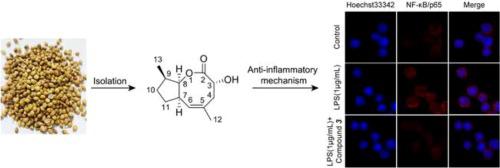Journal of Functional Foods ( IF 3.8 ) Pub Date : 2020-08-01 , DOI: 10.1016/j.jff.2020.104145 Renyikun Yuan , Zhenjie Liu , Jianping Zhao , Qin-Qin Wang , Aiyuan Zuo , Liting Huang , Hongwei Gao , Qiongming Xu , Ikhlas A. Khan , Shilin Yang

|
Coriander, Coriandrum Sativum L., is one of the commonest food and medicinal plants in many countries, but its chemical ingredients and pivotal role in anti-inflammatory activity have not been fully explored. The present study aimed to identify new compounds in the fruits of coriander and explore their anti-inflammatory activity. The compounds were isolated by chromatographic seperations and identified using spectroscopic and spectrometric methods. RAW264.7 macrophage cells were used to detect the anti-inflammatory activity of the compounds via Griess assay, western blotting, ELISA, and flow cytometry methods. The study resulted in the discovery of four new compounds, which were identified as: 4α-(furo[2,3-d]pyrimidin-6′-ylmethyl)-9α-propylnonolactone (1), 4-(formyloxy)-4-(6′-methylcyclohex-1-en-1-yl)butanoate(2), (7α,8α)-3α-hydroxyl-12,13α-dimethyl-5(6)-en-bicyclo[5,3,0]caprolactone (3), 7-methoxy-4-methyl-5,6-dihydro-7H-(2-hydroxypropan-2-yl)furo[2,3-f] coumarin (4). Compound 3 showed the highest anti-inflammatory activity with IC50 of 6.25 μM for an inhibitory effect on nitrite oxide (NO) level. In addition, compound 3 decreased the lipopolysaccharides-stimulated generations of ROS and the inflammatory cytokines (IL-6 and TNF-α). Mechanism exploration indicated that compound 3 suppressed inflammatory mediators’ expression, like iNOS and COX-2. Furthermore, the NF-κB and MAPK pathways were involved in the anti-inflammatory process of compound 3.
中文翻译:

香菜(Coşkuner和Karababa)果实中的新型化合物具有抗炎活性
在许多国家,香菜(Coriandrum Sativum L.)是最常见的食品和药用植物之一,但其化学成分及其在抗炎活性中的关键作用尚未得到充分研究。本研究旨在鉴定香菜果实中的新化合物并探索其抗炎活性。通过色谱分离法分离化合物,并使用光谱和光谱法鉴定。RAW264.7巨噬细胞用于通过Griess分析,蛋白质印迹,ELISA和流式细胞仪方法检测化合物的抗炎活性。该研究导致发现了四个新化合物,它们被鉴定为:4α-(呋喃[2,3-d]嘧啶-6'-基甲基)-9α-丙基壬内酯(1),4-(甲酰氧基)-4-(6'-甲基环己-1-烯-1-基)丁酸酯(2),(7α,8α)-3α-羟基-12,13α-二甲基-5(6)-双环[5,3,0]己内酯(3),7-甲氧基-4-甲基-5,6-二氢-7 H-(2-羟基丙烷-2-基)呋喃[2,3-f]香豆素(4)。化合物3具有最高的抗炎活性,对亚硝酸盐(NO)水平具有抑制作用,IC 50为6.25μM。另外,化合物3减少了脂多糖刺激的ROS的产生和炎性细胞因子(IL-6和TNF-α)。机理研究表明,化合物3抑制炎症介质的表达,如iNOS和COX-2。此外,NF-κB和MAPK途径参与了化合物3的抗炎过程。











































 京公网安备 11010802027423号
京公网安备 11010802027423号